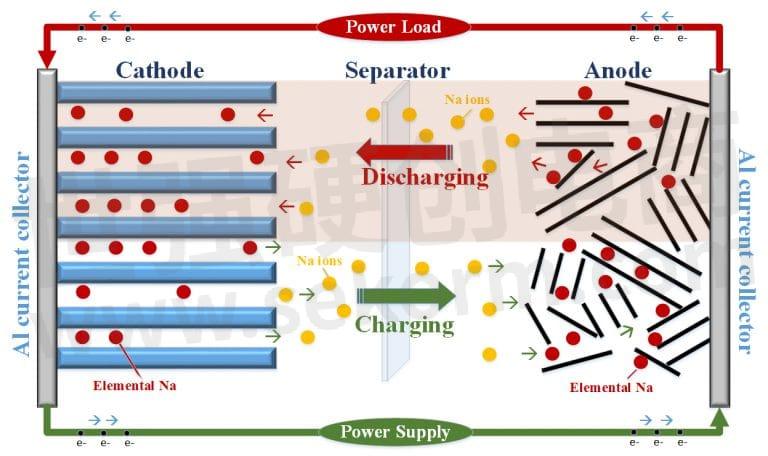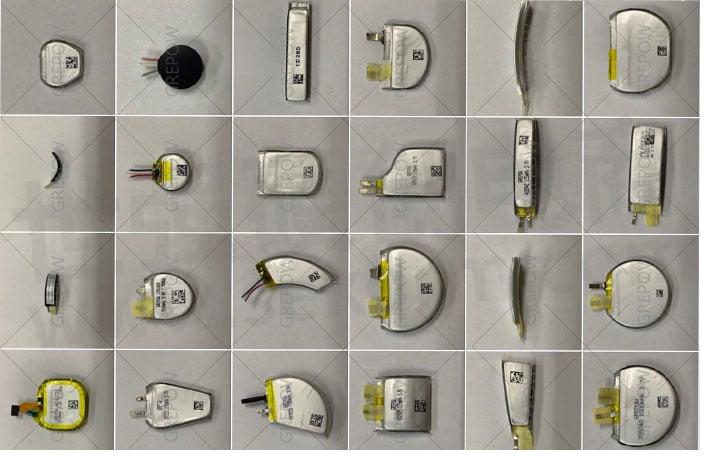Sodium Ion VS Lithium Ion Battery – are Sodium Batteries Better?




Recently, the news of “Sodium-ion battery” (Sodium-ion battery) has come into our field of vision again, setting off another wave of a craze in the battery industry. Some people say that sodium batteries will be the hope of the future, while others say that this is a technology scam. What is going on? Will sodium batteries replace existing lithium-ion and lithium polymer batteries? Today, Grepow will explain to you why.
What is a sodium-ion battery?
In fact, as early as the 1980s, research on sodium-ion batteries had already begun. The electrode materials designed and developed in the early days, such as MoS2, TiS2, and NaxMO2, have poor electrochemical performance, and their development is very slow.

This schematic illustrates the functioning of sodium-ion batteries. The high cost and scarcity of lithium are driving research to develop alternatives to lithium-ion batteries, especially to meet future needs in energy storage. One potential alternative is sodium-ion batteries. (Purdue University image/Vilas Pol)
A sodium-ion battery is a kind of secondary battery (rechargeable battery), which mainly relies on the movement of sodium ions between the positive and negative electrodes to work, similar to the working principle of lithium-ion batteries.
As I just said, neither sodium batteries nor lithium batteries have been discovered in the past two years. It can be said that these two batteries were equally popular in the 1980s, but due to various reasons, sodium batteries have faded out. To improve people’s vision.
In the periodic table of the elements, sodium and lithium are the closest metal elements of the same group, and their chemical properties are very similar. The number of electrons used in the outermost layer of the battery is exactly the same. The carrying capacity of lithium-ion batteries and sodium-ion batteries in charge and discharge reactions are also consistent.
Why did “sodium batteries” disappear from direct sales? Is it because the technology is immature?In fact, it is not. The technical principles of sodium batteries have long been mature and a complete system was formed at that time. Both of these two battery technologies use metal ions as charge carriers. In this transfer process, the charge carries the metal ions and is transferred between the positive electrode and the negative electrode to realize the charge and discharge of the battery. From the point of view of the transmission efficiency of the two, since the amount of electricity carried in the charge and discharge reaction is the same, the transmission efficiency is also the same.
Advantages of sodium batteries
The electrode material used in sodium-ion batteries is mainly sodium salt, which is more abundant and cheaper than lithium. Since sodium-ions are larger than lithium-ions, sodium-ion batteries are a cost-effective alternative when weight and energy density are not high requirements. Compared with lithium-ion batteries, sodium-ion batteries have the following advantages:
The sodium salt raw material reserves are abundant and the price is low. Compared with the ternary cathode material of lithium-ion battery, the iron-manganese-nickel-based cathode material is used, and the raw material cost is reduced by half;
Due to the characteristics of sodium salt, it is allowed to use low-concentration electrolyte (with the same concentration of electrolyte, the conductivity of sodium salt is about 20% higher than that of lithium electrolyte) to reduce costs;
sodium-ions do not form an alloy with aluminum, and aluminum foil can be used as the current collector for the negative electrode, which can further reduce the cost by about 8% and reduce the weight by about 10%;
Since the sodium-ion battery has no over-discharge characteristics, the sodium-ion battery is allowed to discharge to zero volts. The energy density of sodium-ion batteries is greater than 100Wh/kg, which is comparable to lithium iron phosphate batteries, but its cost advantage is obvious, and it is expected to replace traditional lead-acid batteries in large-scale energy storage.
At present, one of the main cost sources of new energy vehicles is the battery. The several advantages of sodium-ion batteries are related to cost. It can be seen that it is expected to reduce the overall cost of new energy vehicles in the future, but its disadvantages are also very obvious: low energy density.
Energy density: sodium battery vs lithium battery
In terms of the volume and mass of sodium-ions and lithium-ions, under the same weight, the volume of sodium is more than three times that of lithium, that is to say, the diameter of sodium-ions is larger and the energy density is much lower than that of lithium batteries.
From the data we have seen on the Internet, the energy density of current sodium-ion batteries is about 80~100Wh/kg. In 2017, a 150Wh/kg sodium-ion battery was developed. Recently, various space compression schemes have been used, and the hybrid design of series and parallel integration of sodium and lithium batteries for new energy vehicle schemes has successfully rescued the energy density of the battery to about 160Wh/kg. To be honest, it can be compared with phosphoric acid. lithium iron phosphate battery (LiFePO4) is comparable and is expected to replace the lead-acid battery market in the field of energy storage.
Nevertheless, lithium-ion batteries can have a higher energy density than sodium-ion batteries and are smaller and lighter. This is where sodium batteries are inherently inferior to lithium batteries.
Advantages of lithium-polymer batteryEnergy Density
In contrast, Grepow’s Lithium Polymer battery has reached a single energy density of 268Wh/kg, and its ternary lithium battery (NMC811) has reached 275Wh/kg. The number of times reached the level of 500 times.
Ultra-fast charging technology
In terms of technological breakthroughs in sodium batteries, in terms of charging, sodium-ion batteries can be charged to more than 80% in only 15 minutes at room temperature. With the current Grepow’s lithium battery technology, the polymer lithium battery can also reach an ultra-fast charging level of up to 5C, which is not the same as the charging time of the sodium battery, and the high-rate lithium iron phosphate battery can be charged in about 20 minutes. More than 80% is not a problem at all.
Degree of freedom of shape
In addition, the polymer lithium battery made by the soft pack lamination process has advantages in weight, shape, and size. For example, the shape can be made into various shapes. It is also called a “shaped battery“. )”.

GREPOW shaped batteries
Judging from the current market situation, the actual application of sodium batteries is far inferior to lithium batteries, and due to the market orientation, sodium batteries lag behind lithium batteries and lack a mature industrial chain. The initial cost is much higher than that of lithium batteries.
Conclusion
In contrast to these advantages and disadvantages, sodium batteries do have a huge market, and with the popularity of new energy vehicles and energy storage industries, they are expected to replace the traditional lead-acid battery market. The prices of cobalt, nickel, and lithium carbonate are constantly increasing. Under the rising market conditions, sodium salt can be said to be a big advantage. But we cannot reject the characteristics and advantages of lithium batteries. At least in the next 30 to 50 years, lithium batteries may still be one of the mainstream batteries in drones, smart wearables, medical and industrial industries.
- |
- +1 赞 0
- 收藏
- 评论 0
本文由电子人生转载自Grepow,原文标题为:Sodium ion vs Lithium Ion Battery – Are Sodium Batteries Better?,本站所有转载文章系出于传递更多信息之目的,且明确注明来源,不希望被转载的媒体或个人可与我们联系,我们将立即进行删除处理。
相关研发服务和供应服务
相关推荐
LFP磷酸铁锂电池和NMC三元锂电池有什么区别?
LFP电池是指磷酸铁锂电池(Lithium Iron Phosphate Battery)的简称。它是一种新型的锂离子电池,由锂离子电池的一种,具有高能量密度、长寿命、安全性好等特点,被广泛应用于电动汽车、储能系统、电动工具等领域,既然如此,那LFP磷酸铁锂电池和NMC三元锂电池的区别有哪些呢?
What is the packaging technology of soft pack Li Ion battery?
Soft pack lithium-ion batteries are always found in consumer electronics, as UAV/drone batteries, and the high-performance batteries of RCs, for military, and automotive industries. This article talks about the packaging technology of soft pack Li Ion battery.
How to Choose Solar System and Deep Cycle Batteries?
Solar panel systems are a little expensive in some cases but are a worthy, long-term investment. Whether it‘s wanted to produce day-to-day energy to our home, vehicle, boat or any other device, or simply to have a sunlight-charged energy backup. Every year more and more people switch to solar power energy, and they have a point. With the increasing concerns of climate change, plus gaining independency in terms of energy supply as in the cases of recreational vehicles. Using solar panels as our source for electricity, looks to be the smart decision to make these days.
Next-Generation eVTOL Battery Technology
The United Nations projects that 68% of the world‘s population will live in urban areas by 2050, up from 55% in 2018. Urban air mobility (UAM)—an ecosystem unlocking the airspace for on-demand passenger and cargo transportation by flying vehicles—has the potential to disrupt urban mobility systems. Electric vertical takeoff and landing (eVTOL) aircraft, combining helicopters’ convenience of local takeoff and landing, airplanes’ efficient aerodynamic flight, and electric powertrains‘ low noise and environmental impact, have emerged as the most promising candidate for UAM.
5 Factors That Affect the Lithium Ion Battery Life
Grepow talks about 5 Factors That Affect the Lithium-Ion Battery Life.
Low-Temperature LiFePO4 Battery: Why It‘s Best For RV
In this article, you will understand how the low-temperature LifePO4 batteries work, and why it is ideal for any RVs. You will also know its features to help you understand this product.
LFP vs NMC Battery: Exploring the Differences
In the realm of energy storage, Lithium Iron Phosphate (LFP) and Nickel Manganese Cobalt (NMC) batteries have emerged as two prominent contenders. Both have unique characteristics and applications, making them popular choices for various industries. LFP vs NMC Battery: What‘s the difference? This article aims to delve into the specifics of LFP and NMC batteries, outlining their features, benefits, and drawbacks.
Prismatic vs Pouch vs Cylindrical Lithium Ion Battery Cell
Lithium-ion batteries have become the energy storage solution of choice for a myriad of applications, ranging from portable electronics to electric vehicles and renewable energy systems. Within the realm of lithium-ion technology, there are various cell designs, each with its unique characteristics and applications. In this article, we delve into the world of prismatic, pouch, and cylindrical lithium-ion battery cells, comparing their structures, advantages, and use cases.
Can Lithium Batteries and Lead Acid Batteries be Used Together?
Both lithium batteries and lead-acid batteries are energy storage batteries, but they also rechargeable batteries with completely different characteristics, so they cannot be used together unless they can be used separately, but must meet the technical requirements, including protective measures.
A Comprehensive Guide to Lithium Ion UPS: Unveiling the Power Behind Backup Systems
Uninterruptible Power Supplies (UPS) play a crucial role in safeguarding electronic devices and critical systems from power disruptions. Traditionally, lead-acid batteries have been the go-to choice for UPS systems, but recent advancements in battery technology have introduced lithium-ion batteries as a viable alternative. In this comprehensive guide, we delve into various aspects of Lithium Ion UPS, addressing common questions and considerations.
Why Do the Voltage of LiFePO4 Batteries Drop Back
Lithium iron phosphate battery (LiFePO4 Battery) as a rechargeable lithium-ion battery, has been widely concerned by friends in the industry, especially in the field of new energy vehicles are getting more and more attention.
What Is LiFePO4 Battery and Why Use It?
LiFePO4 battery becomes more and more popular because of their safety, longevity, and reliability. But what is a LiFePO4 battery, when to choose use it and why it is so expensive? This article will take you into the world of LiFePO4 battery and help you decide whether you should use LiFePO4 batteries.What Is a Lifepo4 Battery?The LiFePO4 battery (lithium iron phosphate) or LFP battery (lithium ferrophosphate) is a specific type of lithium-ion battery known for its robust safety features and impressive cycle life.
What Are the Advantages and Disadvantages of Lfp Battery?
Lithium iron phosphate battery (also known as LFP or LFP battery) has emerged as a leading choice in various applications due to their unique characteristics. In this article, we‘ll explore what LFP batteries are, delve into their advantages, and scrutinize the potential drawbacks associated with this popular energy storage technology.
电子商城






































































































































































































登录 | 立即注册
提交评论